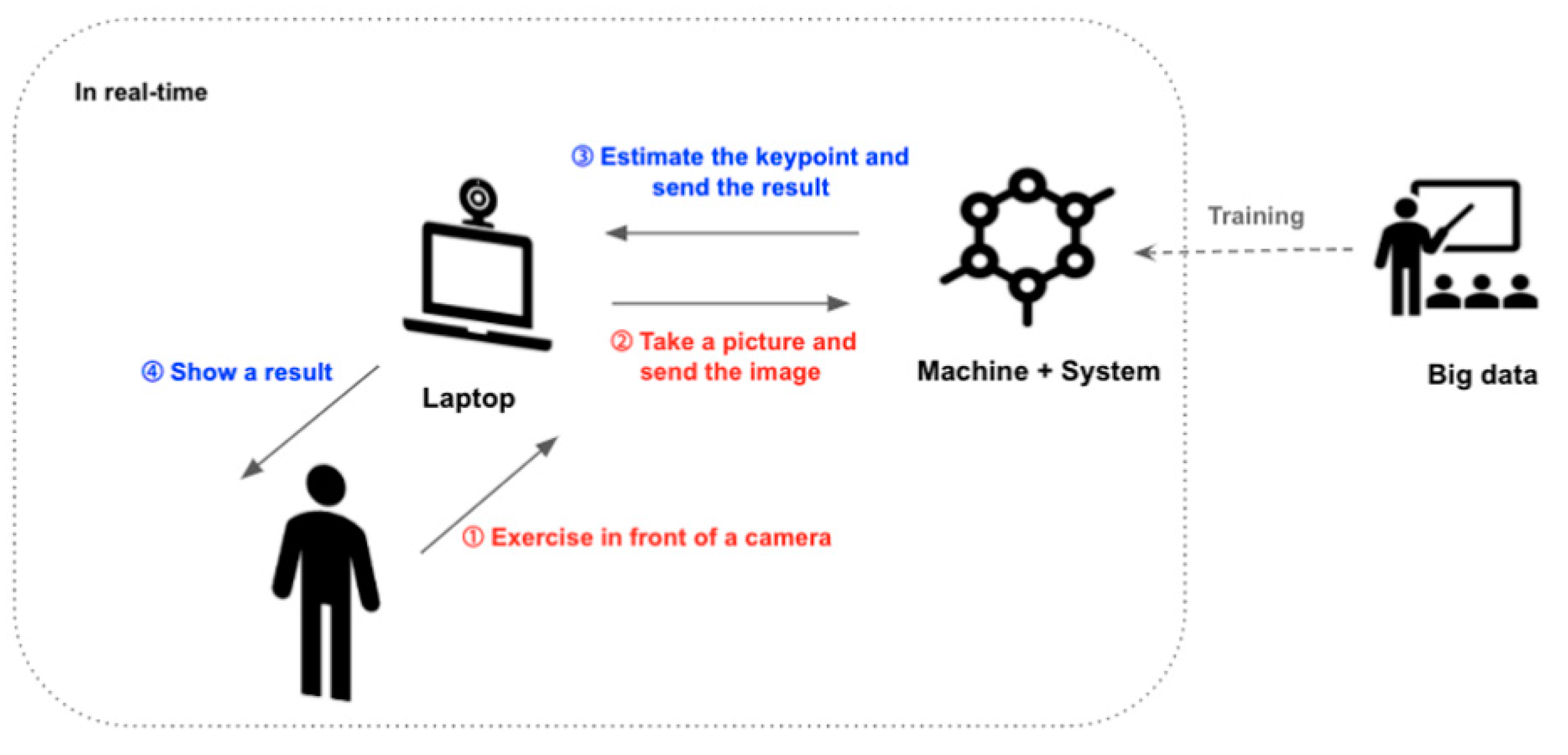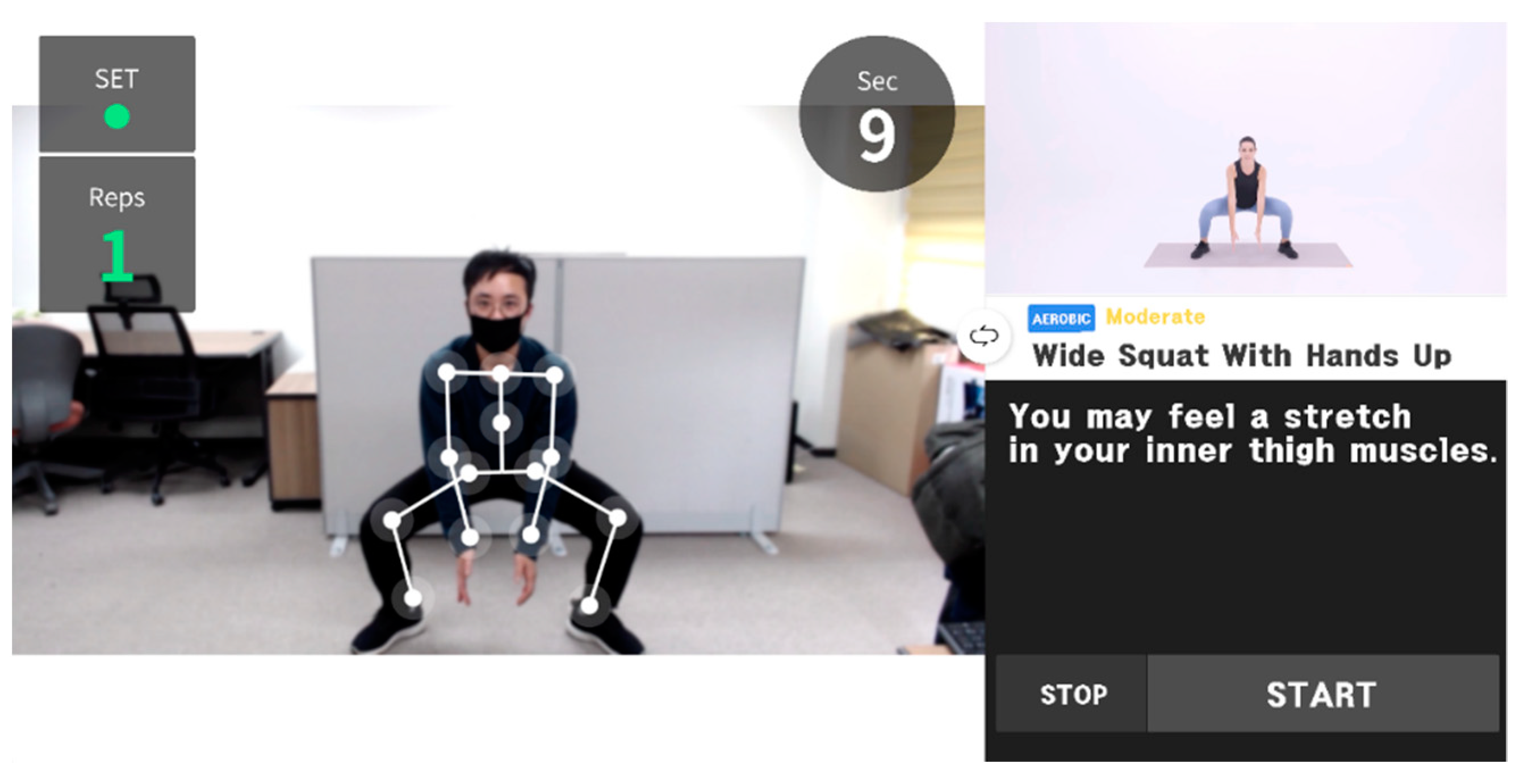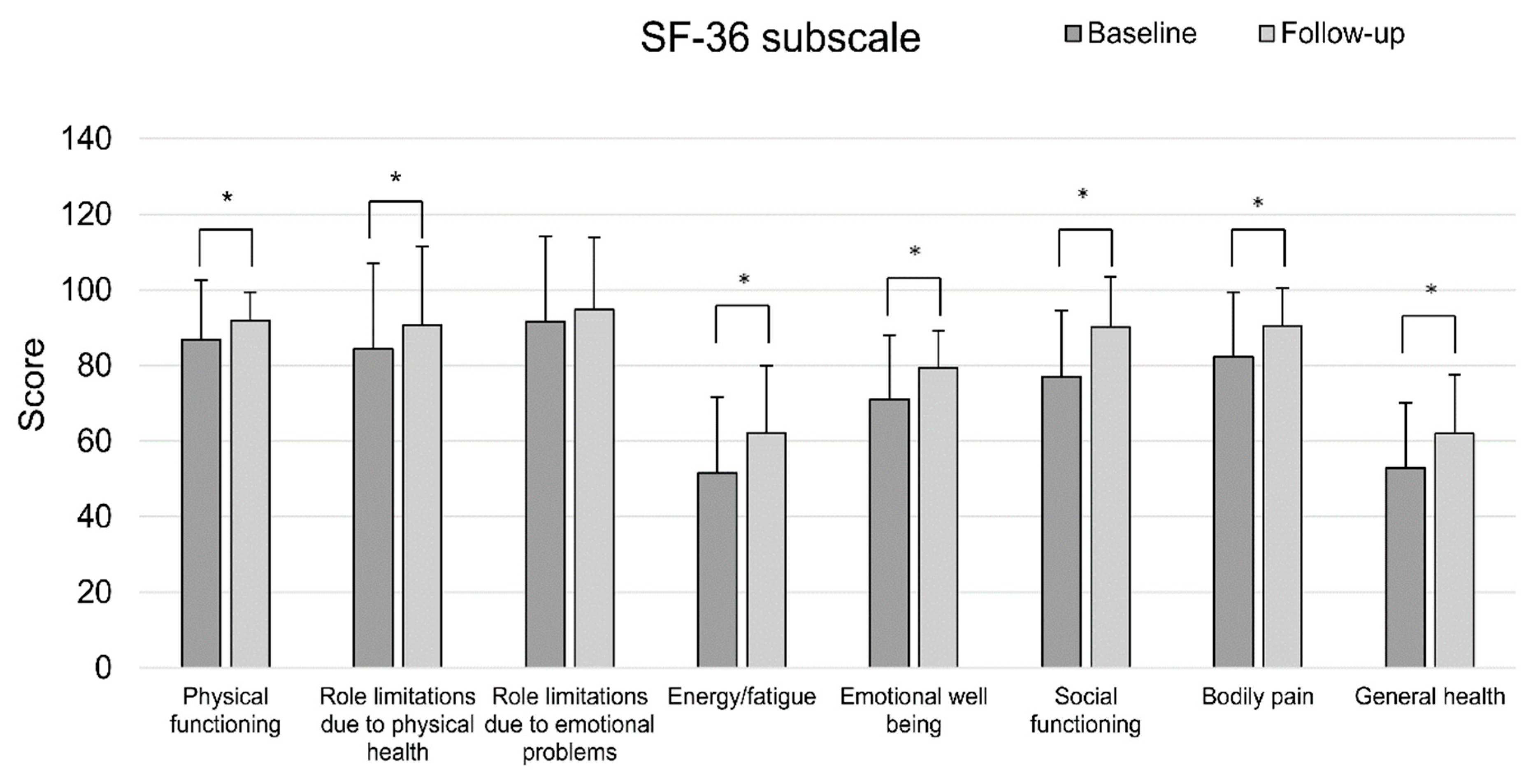Feasibility and Effectiveness of a Motion Tracking-Based Online Fitness Program for Office Workers
Abstract
1. Introduction
2. Materials and Methods
2.1. Subjects
2.2. Weelo
2.3. Intervention
2.4. Assessments
2.5. Physical and Functional Status
2.6. QOL, Fatigue, and Depression
2.7. Satisfaction Survey
2.8. Statistical Analysis
3. Results
4. Discussion
Author Contributions
Funding
Institutional Review Board Statement
Informed Consent Statement
Data Availability Statement
Conflicts of Interest
References
- Thompson, W.R. Worldwide Survey of Fitness Trends for 2021. ACSM’s Health Fit. J. 2021, 25, 10–19. [Google Scholar] [CrossRef]
- Miotto, R.; Danieletto, M.; Scelza, J.R.; Kidd, B.A.; Dudley, J.T. Reflecting health: Smart mirrors for personalized medicine. NPJ Digit. Med. 2018, 1, 62. [Google Scholar] [CrossRef]
- Ni, M.Y.; Hui, R.W.; Li, T.K.; Tam, A.H.; Choy, L.L.; Ma, K.K.; Cheung, F.; Leung, G.M. Augmented Reality Games as a New Class of Physical Activity Interventions? The Impact of Pokémon Go Use and Gaming Intensity on Physical Activity. Games Health J. 2019, 8, 1–6. [Google Scholar] [CrossRef] [PubMed]
- Lewis, B.A.; Napolitano, M.A.; Buman, M.P.; Williams, D.M.; Nigg, C.R. Future directions in physical activity intervention research: Expanding our focus to sedentary behaviors, technology, and dissemination. J. Behav. Med. 2016, 40, 112–126. [Google Scholar] [CrossRef] [PubMed]
- Maugeri, G.; Castrogiovanni, P.; Battaglia, G.; Pippi, R.; D’Agata, V.; Palma, A.; Di Rosa, M.; Musumeci, G. The impact of physical activity on psychological health during Covid-19 pandemic in Italy. Heliyon 2020, 6, e04315. [Google Scholar] [CrossRef] [PubMed]
- Chae, S.H.; Kim, Y.; Lee, K.-S.; Park, H.-S. Development and Clinical Evaluation of a Web-Based Upper Limb Home Rehabilitation System Using a Smartwatch and Machine Learning Model for Chronic Stroke Survivors: Prospective Comparative Study. JMIR mHealth uHealth 2020, 8, e17216. [Google Scholar] [CrossRef] [PubMed]
- Meekes, W.; Stanmore, E.K. Motivational Determinants of Exergame Participation for Older People in Assisted Living Facilities: Mixed-Methods Study. J. Med. Internet Res. 2017, 19, e238. [Google Scholar] [CrossRef]
- Lieberman, D.A.; Chamberlin, B.; Medina, E.; Franklin, B.A.; Sanner, B.M.; Vafiadis, D.K. The power of play: Innovations in Getting Active Summit 2011: A science panel proceedings report from the American Heart Association. Circulation 2011, 123, 2507–2516. [Google Scholar] [CrossRef] [PubMed]
- Osgouei, R.H.; Soulsby, D.; Bello, F. Rehabilitation Exergames: Use of Motion Sensing and Machine Learning to Quantify Exercise Performance in Healthy Volunteers. JMIR Rehabil. Assist. Technol. 2020, 7, e17289. [Google Scholar] [CrossRef]
- Biddiss, E.; Irwin, J. Active Video Games to Promote Physical Activity in Children and Youth. Arch. Pediatr. Adolesc. Med. 2010, 164, 664–672. [Google Scholar] [CrossRef]
- Pratt, M.; Sarmiento, O.L.; Montes, F.; Ogilvie, D.; Marcus, B.H.; Perez, L.G.; Brownson, R.C. The implications of megatrends in information and communication technology and transportation for changes in global physical activity. Lancet 2012, 380, 282–293. [Google Scholar] [CrossRef]
- Peng, W.; Lin, J.-H.; Crouse, J. Is Playing Exergames Really Exercising? A Meta-Analysis of Energy Expenditure in Active Video Games. Cyberpsychol. Behav. Soc. Netw. 2011, 14, 681–688. [Google Scholar] [CrossRef]
- John, E.; Ware, J.; Kosinski, M.; Gandek, B. SF-36 Health Survey: Manual and Interpretation Guide; New England Medical Center, The Health Institute: Boston, MA, USA, 1993. [Google Scholar]
- Cao, Z.; Hidalgo Martinez, G.; Simon, T.; Wei, S.-E.; Sheikh, Y.A. OpenPose: Realtime Multi-Person 2D Pose Estimation using Part Affinity Fields. IEEE Trans. Pattern Anal. Mach. Intell. 2021, 43, 172–186. [Google Scholar] [CrossRef]
- Oh, J.Y.; Yang, Y.J.; Kim, B.S.; Kang, J.H. Validity and Reliability of Korean Version of International Physical Activity Questionnaire (IPAQ) Short Form. J. Korean Acad. Fam. Med. 2007, 28, 532–541. [Google Scholar]
- Craig, C.L.; Marshall, A.L.; Sjöström, M.; Bauman, A.E.; Booth, M.L.; Ainsworth, B.E.; Pratt, M.; Ekelund, U.; Yngve, A.; Sallis, J.F.; et al. International Physical Activity Questionnaire: 12-Country Reliability and Validity. Med. Sci. Sports Exerc. 2003, 35, 1381–1395. [Google Scholar] [CrossRef]
- ATS (American Thoracic Society). Committee on Proficiency Standards for Clinical Pulmonary Function Laboratories ATS Statement: Guidelines for the six-minute walk test. Am. J. Respir. Crit. Care Med. 2002, 166, 111–117. [Google Scholar] [CrossRef]
- Van Lieshout, R.; Reijneveld, E.A.; Berg, S.M.V.D.; Haerkens, G.M.; Koenders, N.H.; De Leeuw, A.J.; Van Oorsouw, R.G.; Paap, D.; Scheffer, E.; Weterings, S.; et al. Reproducibility of the Modified Star Excursion Balance Test Composite and Specific Reach Direction Scores. Int. J. Sports Phys. Ther. 2016, 11, 356–365. [Google Scholar] [PubMed]
- Han, C.-W.; Lee, E.-J.; Iwaya, T.; Kataoka, H.; Kohzuki, M. Development of the Korean Version of Short-Form 36-Item Health Survey: Health Related QOL of Healthy Elderly People and Elderly Patients in Korea. Tohoku J. Exp. Med. 2004, 203, 189–194. [Google Scholar] [CrossRef]
- Lee, J.H.; Jeong, H.S.; Lim, S.M.; Cho, H.B.; Ma, J.; Ko, E.; Im, J.J.; Lee, S.H.; Bae, S.; Lee, Y.-J.; et al. Reliability and Validity of the Fatigue Severity Scale among University Student in South Korea. Korean J. Biol. Psychiatry 2013, 20, 6–11. [Google Scholar]
- Krupp, L.B.; Larocca, N.; Muir-Nash, J.; Steinberg, A.D. The Fatigue Severity Scale. Application to patients with multiple sclerosis and systemic lupus erythematosus. JAMA Neurol. 1989, 46, 1121–1123. [Google Scholar]
- Sung, H.M.; Kim, J.B.; Park, Y.N.; Bai, D.; Lee, S.H.; Ahn, H.N. A Study on the Reliability and the Validity of Korean Version of the Beck Depression Inventory-II (BDI-II). J. Korean Soc. Biol. Ther. Psychiatry 2008, 14, 201–212. [Google Scholar]
- Aaron, T.B.; Robert, A.S.; Gregory, K.B. Manual for the Beck Depression Inventory-II; Psychological Corporation: San Antonio, TX, USA, 1996. [Google Scholar]
- Piercy, K.L.; Troiano, R.P.; Ballard, R.M.; Carlson, S.A.; Fulton, J.E.; Galuska, D.A.; George, S.M.; Olson, R.D. The Physical Activity Guidelines for Americans. JAMA 2018, 320, 2020–2028. [Google Scholar] [CrossRef] [PubMed]
- Díez-Fernández, A.; Martínez-Vizcaíno, V.; Torres-Costoso, A.I.; García-Prieto, J.C.; Morales, P.F.; Sánchez-López, M. Strength and cardiometabolic risk in young adults: The mediator role of aerobic fitness and waist circumference. Scand. J. Med. Sci. Sports 2018, 28, 1801–1807. [Google Scholar] [CrossRef] [PubMed]
- Warburton, D.E.; Nicol, C.W.; Bredin, S.S. Health benefits of physical activity: The evidence. Can. Med. Assoc. J. 2006, 174, 801–809. [Google Scholar] [CrossRef] [PubMed]
- Lee, I.-M.; Skerrett, P.J. Physical activity and all-cause mortality: What is the dose-response relation? Med. Sci. Sports Exerc. 2001, 33, S459–S471. [Google Scholar] [CrossRef]
- Oliveira, C.B.; Pinto, R.Z.; Saraiva, B.T.C.; Tebar, W.R.; Delfino, L.D.; Franco, M.R.; Silva, C.C.M.; Christofaro, D.G.D. Effects of active video games on children and adolescents: A systematic review with meta-analysis. Scand. J. Med. Sci. Sports 2019, 30, 4–12. [Google Scholar] [CrossRef]
- Fischetti, F.; Greco, G.; Cataldi, S.; Minoia, C.; Loseto, G.; Guarini, A. Effects of Physical Exercise Intervention on Psychological and Physical Fitness in Lymphoma Patients. Medicina (Kaunas) 2019, 55, 379. [Google Scholar] [CrossRef]
- Gschwind, Y.J.; Kressig, R.W.; Lacroix, A.; Muehlbauer, T.; Pfenninger, B.; Granacher, U. A best practice fall prevention exercise program to improve balance, strength/power, and psychosocial health in older adults: Study protocol for a randomized controlled trial. BMC Geriatr. 2013, 13, 105. [Google Scholar] [CrossRef] [PubMed]
- House, G.; Burdea, G.; Grampurohit, N.; Polistico, K.; Roll, D.; Damiani, F.; Hundal, J.; Demesmin, D. A feasibility study to determine the benefits of upper extremity virtual rehabilitation therapy for coping with chronic pain post-cancer surgery. Br. J. Pain 2016, 10, 186–197. [Google Scholar] [CrossRef]
- Ettman, C.K.; Abdalla, S.M.; Cohen, G.H.; Sampson, L.; Vivier, P.M.; Galea, S. Prevalence of Depression Symptoms in US Adults Before and During the COVID-19 Pandemic. JAMA Netw. Open 2020, 3, e2019686. [Google Scholar] [CrossRef]
- Costa, M.T.S.; Vieira, L.P.; Barbosa, E.D.O.; Oliveira, L.M.; Maillot, P.; Vaghetti, C.A.O.; Carta, M.G.; Machado, S.; Gatica-Rojas, V.; Monteiro-Junior, R.S. Virtual Reality-Based Exercise with Exergames as Medicine in Different Contexts: A Short Review. Clin. Pract. Epidemiol. Ment. Health 2019, 15, 15–20. [Google Scholar] [CrossRef]
- Tsuda, K.; Sudo, K.; Goto, G.; Takai, M.; Itokawa, T.; Isshiki, T.; Takei, N.; Tanimoto, T.; Komatsu, T. A Feasibility Study of Virtual Reality Exercise in Elderly Patients with Hematologic Malignancies Receiving Chemotherapy. Intern. Med. 2016, 55, 347–352. [Google Scholar] [CrossRef]
- Karahan, A.Y.; Tok, F.; Taşkın, H.; Kuçuksaraç, S.; Başaran, A.; Yıldırım, P. Effects of Exergames on Balance, Functional Mobility, and Quality of Life of Geriatrics Versus Home Exercise Programme: Randomized Controlled Study. Cent. Eur. J. Public Health 2015, 23, S14–S18. [Google Scholar] [CrossRef] [PubMed]
- Sun, H. Impact of exergames on physical activity and motivation in elementary school students: A follow-up study. J. Sport Health Sci. 2013, 2, 138–145. [Google Scholar] [CrossRef]
- Soltani, P.; Figueiredo, P.; Vilas-Boas, J.P. Does exergaming drive future physical activity and sport intentions? J. Health Psychol. 2020, 1359105320909866. [Google Scholar] [CrossRef] [PubMed]
- Mackintosh, K.A.; Standage, M.; Staiano, A.E.; Lester, L.; McNarry, M.A. Investigating the Physiological and Psychosocial Responses of Single- and Dual-Player Exergaming in Young Adults. Games Health J. 2016, 5, 375–381. [Google Scholar] [CrossRef] [PubMed]
- White, K.; Schofield, G.; Kilding, A.E. Energy expended by boys playing active video games. J. Sci. Med. Sport 2011, 14, 130–134. [Google Scholar] [CrossRef]
- Sell, K.; Lillie, T.; Taylor, J. Energy Expenditure During Physically Interactive Video Game Playing in Male College Students With Different Playing Experience. J. Am. Coll. Health 2008, 56, 505–511. [Google Scholar] [CrossRef]



| Stretching Exercises | Strengthening Exercises | Aerobic Exercise |
|---|---|---|
| Quadriceps stretch Back stretch Side bend stretch Abdomen stretch Shoulder rotation stretch Overhead shoulder stretch Triceps stretch Cross shoulder stretch Chest stretch Rhomboids stretch Trapezius stretch Neck flexion stretch Neck extension stretch Neck rotation stretch Neck lateral flexion stretch | Isometric cervical flexion Isometric cervical extension Dumbbell bent-over row Y raise Shoulder external rotation Dumbbell shoulder press Arnold press Upright row Side lateral raise Front raise Bent over lateral raise Dumbbell curl Hammer curl Dead lift One leg dead lift Side band Squat Wide squat Side lunge Skate lunge | Jump twist Knee up Wide squat with hands up Toe touch Step jack with side lunge Step jack Side elbow Twist elbow Speed skaters Fly jack High knee Jumping jack Walking in place Running in place |
| Characteristics | N = 32 |
|---|---|
| Age (years) | 35.26 ± 6.79 |
| Male: Female | 14:18 |
| Height (cm) | 168.59 ± 9.00 |
| Right-handed: Left-handed | 29:3 |
| Married: Unmarried | 20:12 |
| Physically active: Non-active | 7:25 |
| Variables | Pre | Post | p |
|---|---|---|---|
| Body composition | |||
| Body weight (kg) | 69.65 ± 16.06 | 69.56 ± 15.97 | 0.697 |
| Body mass index (kg/m2) | 24.24 ± 3.76 | 24.23 ± 3.78 | 0.865 |
| Skeletal muscle mass (kg) | 27.69 ± 7.55 | 27.63 ± 7.42 | 0.431 |
| Body fat (%) | 28.33 ± 5.91 | 28.34 ± 6.01 | 0.951 |
| Hand grip strength | |||
| Right side (kg) | 35.55 ± 13.21 | 39.61 ± 12.91 | <0.001 * |
| Left side (kg) | 33.76 ± 11.52 | 38.08 ± 11.83 | <0.001 * |
| Modified star excursion balance test | |||
| Right side (cm) | 85.61 ± 10.04 | 94.33 ± 7.67 | <0.001 * |
| Left side (cm) | 85.81 ± 11.00 | 95.28 ± 8.29 | <0.001 * |
| Aerobic capacity & endurance | |||
| 6-min walk test(m) | 520.27 ± 48.9 | 559.02 ± 42.06 | <0.001 * |
| Pain | |||
| Visual analog scale | 3.47 ± 2.77 | 2.78 ± 2.17 | 0.195 |
| Short form 36 | |||
| Physical functioning | 86.88 ± 15.70 | 91.88 ± 7.59 | 0.002 * |
| Role limitations due to physical health | 84.38 ± 22.67 | 90.63 ± 20.82 | 0.041 * |
| Role limitations due to emotional problems | 91.67 ± 22.40 | 94.79 ± 19.14 | 0.206 |
| Energy/fatigue | 20.63 ± 8.01 | 24.88 ± 7.11 | <0.001 * |
| Emotional well-being | 71.00 ± 16.94 | 79.38 ± 9.86 | 0.001 * |
| Social functioning | 76.95 ± 17.71 | 90.23 ± 13.37 | 0.031 * |
| Bodily pain | 82.27 ± 17.13 | 90.55 ± 9.95 | 0.004 * |
| General health | 52.81 ± 17.22 | 62.03 ± 15.55 | <0.001 * |
| Fatigue | |||
| Fatigue severity scale | 3.86 ± 1.58 | 3.13 ± 1.14 | 0.002 * |
| Depression | |||
| Beck depression index | 7.00 ± 5.71 | 4.06 ± 3.98 | <0.001 * |
| International Physical Activity Questionnaire | |||
| Vigorous (METs/week) | 228.86 ± 456.56 | 577.54 ± 651.75 | 0.001 * |
| Moderate (METs/week) | 276.27 ± 423.38 | 436.28 ± 300.61 | 0.022 * |
| Mild (METs/week) | 796.16 ± 802.25 | 571.31 ± 361.37 | 0.089 |
| Time spent sitting (min/day) | 337.03 ± 219.63 | 337.13 ± 204.21 | 0.998 |
| I. Likert scale Questions | Strongly Agree | Agree | Neutral | Disagree | Strongly Disagree |
Net Percent Agreeing (%) | Mean Score | ||
|---|---|---|---|---|---|---|---|---|---|
| Do you think that the Weelo exercise program was effective physically and mentally? | 4 | 22 | 5 | 1 | 0 | 81.25 | 3.91 | ||
| Do you think that the Weelo exercise program is better than the exercises that you have done before (home training, gym, yoga, etc.)? | 3 | 15 | 10 | 5 | 0 | 56.25 | 3.5 | ||
| Did the auditory explanation and feedback provided during the exercise program help you perform the exercise? | 2 | 12 | 11 | 5 | 2 | 43.75 | 3.22 | ||
| Did the visual explanation and feedback provided during the exercise program help you perform the exercise? | 3 | 14 | 9 | 6 | 0 | 53.12 | 3.44 | ||
| Was it easy to handle and operate the program with a laptop during exercise? | 10 | 18 | 1 | 2 | 0 | 87.50 | 4.09 | ||
| Did you feel that the exercise program was interesting? | 3 | 12 | 11 | 5 | 1 | 46.88 | 3.34 | ||
| If it is still available, would you like to use this program after your participation in the study is over? | 6 | 10 | 13 | 2 | 1 | 50.00 | 3.56 | ||
| After participating in the study, were you motivated to continue exercising? | 11 | 20 | 1 | 0 | 0 | 96.88 | 4.31 | ||
| II. Preference of exercise and intensity | |||||||||
| Aerobic | Strengthening | Stretching | |||||||
| What type of exercise program did you find most satisfying and helpful to you? | 4 (12.5%) | 21 (65.63%) | 7 (21.88%) | ||||||
| Strong | Appropriate | Weak | |||||||
| Was the exercise intensity of the provided exercise program appropriate for you? | 7 (21.88%) | 21 (65.63%) | 4 (12.5%) | ||||||
Publisher’s Note: MDPI stays neutral with regard to jurisdictional claims in published maps and institutional affiliations. |
© 2021 by the authors. Licensee MDPI, Basel, Switzerland. This article is an open access article distributed under the terms and conditions of the Creative Commons Attribution (CC BY) license (https://creativecommons.org/licenses/by/4.0/).
Share and Cite
Joo, S.-Y.; Lee, C.-B.; Joo, N.-Y.; Kim, C.-R. Feasibility and Effectiveness of a Motion Tracking-Based Online Fitness Program for Office Workers. Healthcare 2021, 9, 584. https://doi.org/10.3390/healthcare9050584
Joo S-Y, Lee C-B, Joo N-Y, Kim C-R. Feasibility and Effectiveness of a Motion Tracking-Based Online Fitness Program for Office Workers. Healthcare. 2021; 9(5):584. https://doi.org/10.3390/healthcare9050584
Chicago/Turabian StyleJoo, Sun-Young, Chang-Bae Lee, Na-Young Joo, and Chung-Reen Kim. 2021. "Feasibility and Effectiveness of a Motion Tracking-Based Online Fitness Program for Office Workers" Healthcare 9, no. 5: 584. https://doi.org/10.3390/healthcare9050584
APA StyleJoo, S.-Y., Lee, C.-B., Joo, N.-Y., & Kim, C.-R. (2021). Feasibility and Effectiveness of a Motion Tracking-Based Online Fitness Program for Office Workers. Healthcare, 9(5), 584. https://doi.org/10.3390/healthcare9050584






